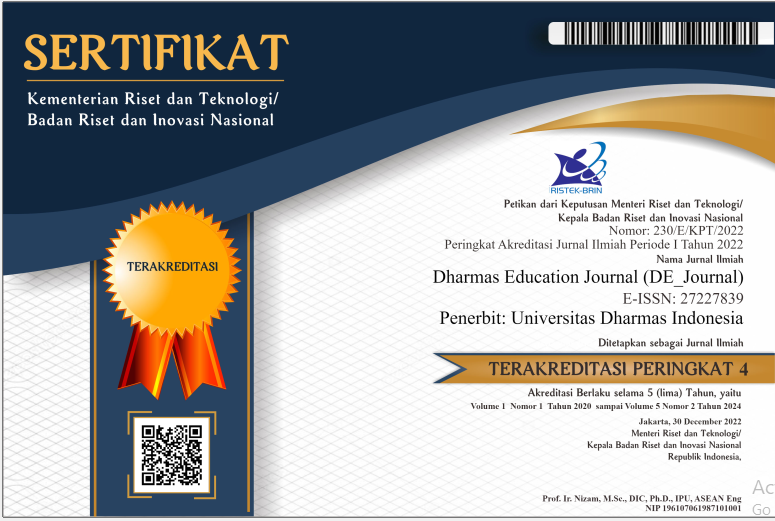DESIGN MID TEST II OF MATH MATERIALS BASED ON HIGHER ORDER THINKING SKILL (HOTS) TAKSONOMI BLOOM REVISION ON CLASS V
DOI:
https://doi.org/10.56667/dejournal.v1i2.68Keywords:
Design, HOTS, Bloom's taxonomyAbstract
The reality that happened in the field was that not all of the test questions made referred to HOTS. Lack of availability of HOTS-based questions causes students to be less trained in developing higher order thinking skills. There are six kinds of Revision of Bloom's taxonomy purpused by Lorin Anderson and David Krathwohl (2001) : C1 knowing, C2understanding, C3aplying, C4 analyzing, C5 evaluating, and C6 creates creating. The test questions classified as HOTS are C4 analyzing, C5 evaluating, and C6 creating. This research is clasified as research and development (R & D) developed by Gall, J. P., & Borg, (2003) namely finding Potentials and Problems, Data Collection, Product Design, Design Validation, and Design Revision. In this study, the product developed was the Middle Semester Assessment test questions on the Mathematics content of class V. The results of the validity were determined by 3 validators using observation sheets. The validity of this question is seen from the suitability of content, construction, and language obtained from validator I getting a score of 81.17% with very valid criteria, validator II getting a score of 77.25% with valid criteria, and validator III getting a score of 94.22% with very valid criteria, with reliability 0,680 (Good).
Downloads
References
Arikunto. (2006). Metodologi Penelitian. Populasi Dan Sampel Penelitian, 130–131.
Brookhart, S. M. (2010). How to Asess Higher Order Thingking Skill in Your Classroom. In Journal of Education (Vol. 88, Issue 18). https://doi.org/10.1177/002205741808801819
Budiman, A., & Jailani. (2014). Pengembangan Instrumen Asesmen Higher Order Thinking Skill (HOTS) ... ( Agus Budiman, Jailani ) - 139. Jurnal Riset Pendidikan Matematika, 1 (2), 139–151.
Daher, W., & Baya, N. (2015). Integrating HOTS Activities with GeoGebra in Pre-Service Teachers ’ Preparation. International Journal of Social, Behavioral, Educational, Economic, Business and Industrial Engineering, 9(7), 2376–2379. https://www.researchgate.net/publication 283122030
Driana, E., & Ernawati, E. (2019). Teachers’ Understanding And Practices In Assessing Higher Order Thinking Skills At Primary Schools. Acitya Journal of Teaching & Education, 1(2), 110–118. https://doi.org/10.30650/ajte.v1i2.233
Ermawati, S., & Taufiq, H. (2017). Penilaian Autentik dan Relevansinya dengan Kualitas Hasil Pembelajaran (Persepsi Dosen dan Mahasiswa IKIP PGRI Bojonegoro). Jurnal Pendidikan Ilmu Sosial, 27(1), 92–103.
Gall, M. D., Gall, J. P., & Borg, W. R. (2003). Educational research: An introduction (7th ed.). In Boston, MA: A & B Publications.
Helda Apganendaria Ongge. (2019). Konsep HOTS dalam pembelajaran. Konsep HOTS Dalam Pembelajaran, 04.
Intan, F. M., Kuntarto, E., & Alirmansyah, A. (2020). Kemampuan Siswa dalam Mengerjakan Soal HOTS (Higher Order Thinking Skills) pada Pembelajaran Matematika di Kelas V Sekolah Dasar. JPDI (Jurnal Pendidikan Dasar Indonesia), 5(1), 6. https://doi.org/10.26737/jpdi.v5i1.1666
Qomariyah. (2014). Kesiapan Guru dalam Menghadapi Implementasi Kurikulum 2013. Jurnal Pendidikan Ekonomi IKIP Veteran Semarang, 2(1), 21–35. https://media.neliti.com/media/publications/37076-ID-kesiapan-guru-dalam-menghadapi-implementasi-kurikulum-2013.pdf
Rapih, S., & Sutaryadi, S. (2018). Perpektif guru sekolah dasar terhadap Higher Order Thinking Skills (HOTS): pemahaman, penerapan dan hambatan. Premiere Educandum : Jurnal Pendidikan Dasar Dan Pembelajaran, 8(1), 78. https://doi.org/10.25273/pe.v8i1.2560
Retnawati, H., Djidu, H., Kartianom, Apino, E., & Anazifa, R. D. (2018). Teachers’ Knowledge About Higher-Order Thinking Skills And Its Learning Strategy. Problems of Education in the 21st Century, 76(2), 215–230.
Retnawati, H., Jailani, Sugiman, Bukhori, Apino, E., Djidu, H., & Arifin, Z. (2018). Desain Pembelajaran Matematika Untuk Melatih Higher Order Thinking Skills. In UNY Press (Vol. 112, Issue September 2019). https://doi.org/10.1192/bjp.112.483.211-a
Saraswati, P. M. S., & Agustika, G. N. S. (2020). Kemampuan Berpikir Tingkat Tinggi Dalam Menyelesaikan Soal HOTS Mata Pelajaran Matematika. Jurnal Ilmiah Sekolah Dasar, 4(2), 257. https://doi.org/10.23887/jisd.v4i2.25336
Sugiyono. (2012). Metode Penelitian Administrasi Dilengkapi dengan Metode R&D. In Bandung: Alfabeta. https://doi.org/10.1007/s11116-011-9347-8
Yuliandini, N., Hamdu, G., & Respati, R. (2019). PEDADIDAKTIKA: Jurnal Ilmiah Pendidikan Guru Sekolah Dasar Pengembangan Soal Tes Berbasis Higher Order Thinking Skill (HOTS) Taksonomi Bloom Revisi di Sekolah Dasar. In All rights reserved (Vol. 6, Issue 1).
Downloads
Published
How to Cite
Issue
Section
License
Copyright (c) 2020 DE_JOURNAL (Dharmas Education Journal)

This work is licensed under a Creative Commons Attribution-NonCommercial-NoDerivatives 4.0 International License.
Makalah yang disampaikan diasumsikan tidak mengandung bahan propietary yang tidak dilindungi oleh hak paten















